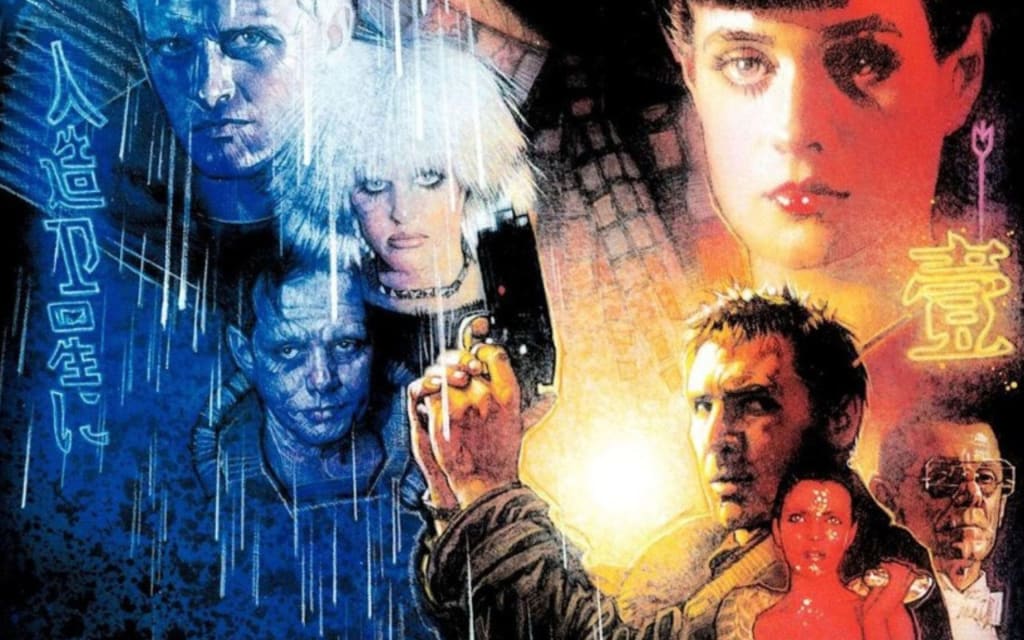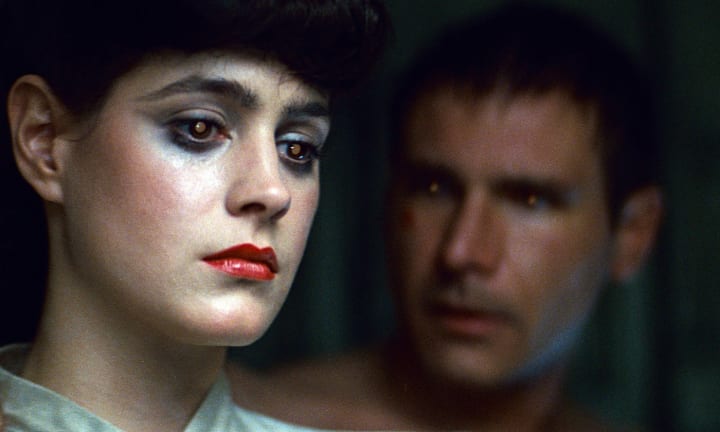Will Facebook Create 'Blade Runner' Replicants?
Living too deeply in Facebook could turn us into 'Blade Runner'-esque Replicants, trying to feel real.

In his 1999 book, Culture Jam, Adbusters founder Kalle Lasn describes a scene in which two people are embarking on a road trip and speak to each other along the way using only quotations from movies.
We’ve all felt our lived experience slip into technological mediation and representation stored on YouTube, Facebook and SnapFish. Based on this idea—and the rampant branding and advertising covering every visible surface— Lasn argues that our culture has inducted us into a cult. "By consensus, cult members speak a kind of corporate Esperanto," he writes, "words and ideas sucked up from TV and advertising." Indeed, we quote television shows, allude to fictional characters and situations, and repeat song lyrics and slogans in everyday conversation. Lasn argues, "We have been recruited into roles and behavior patterns we did not consciously choose."
Lasn presents this scenario as if it were a nightmare. To many of us, however, it’s not only familiar—it actually sounds fun. Cultural allusions are game of sorts. They create a situation that one gets or doesn’t. To "get it" is to be in on the gag. Besides, our media is so saturated with allusions that we scarcely think about them as such. Any given episode of a popular television show like Family Guy or South Park yields references to countless artifacts and cultural detritus. The humor in such media relies, in large part, on the catching and interpretation of allusive pop-culture references—on an audience that shares the same cultural memories. This isn’t exclusive to television. Hip-hop, for example, with its rife repurposing of sounds via sampling and lyrical allusions, is an entire culture built on appropriating cultural artifacts and recognizing shared memories.

In Ridley Scott’s classic 1982 film Blade Runner, advanced humanoid androids, known as "Replicants," base their "human" past on implanted memories. Perhaps had Facebook existed in 1982 Ridley Scott would have had the creators of replicants give them social media cages to refer to instead of physical photographs. Their intelligence is impressive, but not grounded in a larger cognitive context. Instead, they are programmed with memories to make them feel more human. As their inventor, Dr. Eldon Tyrell, explains to Harrison Ford’s Replicant hunter, Deckard:
"We began to recognize in them strange obsession. After all, they are emotionally inexperienced with only a few years in which to store up the experiences which you and I take for granted. If we gift them the past, we create a cushion or pillow for their emotions, and consequently we can control them better."
The cushion of nostalgia buoys us all. We often feel not only justified but emboldened by claims that previous times were superior, even when we don’t quite remember them. "Of course things used to be better!" we think. "The past is not the issue at all," writes Norman M. Klein in his book The History of Forgetting, "it serves merely as a ‘rosy’ container for the anxieties of the present." In the face of contemporary anxieties, we long for times we never knew.
Lasn argues that this makes us victims of culture’s corporate commodification. We’re no better than Replicants, walking around with implanted memories courtesy of the mass media, and its rampant reproduction of artifacts. To most of us, however, the sharing of memories, of cultural allusions, bonds us together and gives us a sense of belonging. A lot of this togetherness is due to the technological reproduction of media. As the influential midcentury media theorist Walter Benjamin writes,
"…technical reproduction can put the copy of the original into situations which would be out of reach for the original itself. Above all, it enables the original to meet the beholder halfway, be it in the form of a photograph or a phonograph record."
Replicants are obsessed with photographs. Where the Replicants can’t be entirely sure of the validity of their own pasts, pictures provide a visual totem, a physical connection to the implanted “cushion” of their memories. In our world, photographs—as well as the phonograph records of Benjamin’s critique—have long since given way to digital reproductions. We’ve managed to abstract the media even further, by manipulating the digital to evoke previous analog formats. As filters on digital photos make images look "vintage," and digital effects make recordings sound like scratchy vinyl, we are facing crisis of context. It’s not just longing. It’s the undermining of that longing.
Much like Lasn, Walter Benjamin was crucially concerned with whether mass culture is a site of exploitation or emancipation. He was equally concerned with authenticity. “The presence of the original is the prerequisite to the concept of authenticity,” he writes. The empty nostalgia of our implanted memories holds no original and no original context. Benjamin continues,
"The whole sphere of authenticity is outside technical–and, of course, not only technical–reproducibility. Confronted with its manual reproduction, which was usually branded as a forgery, the original preserved all its authority; not so vis à vis technical reproduction."
All of these tribulations may seem trivial, but, as technology critic Jaron Lanier writes, "…pop culture is important. It drags us all along with it; it is our shared fate. We can’t simply remain aloof." If pop culture is just recycling plastic pieces of the past, however, where exactly it is dragging us?
The British music critic Simon Reynolds, who calls our obsession with the past "retromania," draws a parallel between nostalgic record collecting and finance. “A hipster stock market based around trading in pasts, not futures,” in which a crash is inevitable: "The world economy was brought down by derivatives and bad debt; music has been depleted of meaning through derivatives and indebtedness." In such a scenario the "original" is even more revered, not just in spite of but also because of its replication. It’s hard to be a purist when nothing is pure.
"Below the surface of these new media, distinguishing context is even dodgier. As Clay Shirky writes, 'Since all the data is digital (expressed as numbers), there is no such thing as a copy anymore. Every piece of data… is identical to every other version of the same piece of data.' Unlike most analog media, there’s no such thing as an original in the digital."
With this in mind, Abby Smith emphasizes:
"...When all data are recorded as 0s and 1s, there is, essentially, no object that exists outside of the act of retrieval. The demand for access creates the “object,” that is, the act of retrieval precipitates the temporary reassembling of 0s and 1s into a meaningful sequence that can be decoded by software and hardware. A digital art-exhibition catalog, digital comic books, or digital pornography all present themselves as the same, all are literally indistinguishable one from another during storage, unlike, say, a book on a shelf."
Analog media show their wear through patina of use. Books show "shelf-wear." Vinyl records—even compact discs—display gouges and scratches. Scratches, scrapes, scars, stretches, tears, marks, grooves: these are analog concepts. Digital artifacts black-box their wear, hiding their story and its context from us. We have to hold it all in our heads.
If we are to avoid being, or becoming, little more than Replicants, we must be more mindful of the contexts floating around us. Being able to translate data into meaning requires paying closer attention to the banks it bridges. Just because digital artifacts are infinitely repeatable doesn’t make them inexhaustible. Authenticity is up to the person—not the memory.
Rick Deckard, played by Harrison Ford, is forced to continue his career as a Replicant Hunter, prowling the steel-and-microchip jungle of 21st Century Los Angeles. His assignment is to kill four escaped Replicants that have returned to earth. Before starting the mission, he meets Rachel, a young Replicant girl that he falls for.
About the Creator
Roy Christopher
I am Roy Christopher. I be thinking about stuff. Sometimes I write about it. "I marshal the middle between Mathers and McLuhan."






Comments
There are no comments for this story
Be the first to respond and start the conversation.